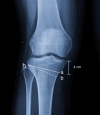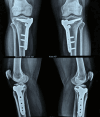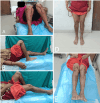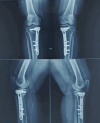Medial Opening Wedge Osteotomy for Early Osteoarthritis of the Knee With Dr. Saigal's Plate: A Case Report With Review of Literature
- PMID: 39742172
- PMCID: PMC11687636
- DOI: 10.7759/cureus.74913
Medial Opening Wedge Osteotomy for Early Osteoarthritis of the Knee With Dr. Saigal's Plate: A Case Report With Review of Literature
Abstract
Knee pain in patients often involves varus deformity and unicompartmental osteoarthritis (OA). High tibial valgus osteotomy (HTO) is increasingly recognized as an effective treatment, as it realigns the knee's mechanical axis towards the healthier lateral compartment, delaying degenerative changes in the medial compartment and reducing the need for joint replacement. This case report discusses two patients with bilateral knee arthritis and varus deformity who underwent medial opening-wedge high tibial osteotomy (MOWHTO) using Dr. Saigal's plate (Nebula Surgical Pvt. Ltd., Gujarat, India). The first patient, a 45-year-old male with a BMI of 29.3 kg/m², had a good range of motion (ROM) and no ligamentous laxity. The second patient, a 36-year-old female with a BMI of 30 kg/m², also exhibited good knee ROM and no ligamentous laxity. Initial evaluation included comprehensive radiological assessments via four X-rays: anteroposterior (AP) view in 30-degree flexion, lateral view, skyline view for the patellofemoral joint, and a standing orthosonogram view from the hip to the toes. The surgical technique aimed to correct varus angulation with valgus overcorrection. Preoperative preparation followed the Miniaci Method, involving a weight-bearing AP orthoscan of the entire leg to determine the corrective angle. Postoperatively, a protocol focused on fixation rigidity allowed toe-touch walking after six weeks. Suture removal occurred on the 14th day with no NSAIDs administered. Data were collected preoperatively, intraoperatively, and at three, six, and twelve months postoperatively. Primary outcomes included the Oxford Knee Score (OKS), Western Ontario and McMaster Universities Osteoarthritis Index (WOMAC), and ROM. Secondary measures assessed mechanical axis deviation (MAD), correction of varus angulation, pain levels, and complications using the Modified RUST criteria for osteotomy site evaluation. At the final follow-up, both patients showed excellent clinical outcomes with pain-free joint motion and optimal limb alignment. No complications such as infection, hardware failure, or need for total knee replacement were reported. The mean preoperative OKS significantly improved, indicating the procedure's effectiveness in enhancing function and quality of life. The WOMAC pain and functional subscores also improved consistently over the year. Although there was a temporary decrease in knee ROM initially, it rebounded by the final assessments. Overall, the intervention was safe and successful, with no deep infections, deep vein thrombosis, lateral hinge fractures, varus collapse, or implant failures reported.
Keywords: dr saigal; hto; lateral hinge fracture; mechanical axis deviation; medial open wedge osteotomy; medial opening wedge osteotomy; miniaci; modified rust criteria; osteoarthritis (oa); western ontario and mcmaster universities osteoarthritis index.
Copyright © 2024, Agrawal et al.
Conflict of interest statement
Human subjects: Consent for treatment and open access publication was obtained or waived by all participants in this study. Institute Ethical Committee issued approval 2711/IEC-AIIMSRPR/2023. At Institute Ethics Committee meeting held on 21/01/2023,the committee reviewed the research project and the study related document and discussed the ethical issues involved. No ethical issues was identified.Hence ,IEC deided to approve the above referenced project. . Conflicts of interest: In compliance with the ICMJE uniform disclosure form, all authors declare the following: Payment/services info: All authors have declared that no financial support was received from any organization for the submitted work. Financial relationships: All authors have declared that they have no financial relationships at present or within the previous three years with any organizations that might have an interest in the submitted work. Other relationships: All authors have declared that there are no other relationships or activities that could appear to have influenced the submitted work.
Figures

















References
Publication types
LinkOut - more resources
Full Text Sources
